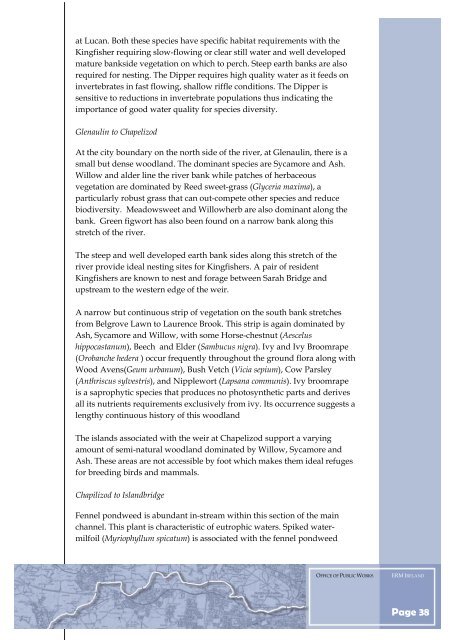Towards a Liffey Valley Strategy Doc. 1 - Kildare.ie
Towards a Liffey Valley Strategy Doc. 1 - Kildare.ie
Towards a Liffey Valley Strategy Doc. 1 - Kildare.ie
Create successful ePaper yourself
Turn your PDF publications into a flip-book with our unique Google optimized e-Paper software.
at Lucan. Both these spec<strong>ie</strong>s have specific habitat requirements with the<br />
Kingfisher requiring slow-flowing or clear still water and well developed<br />
mature bankside vegetation on which to perch. Steep earth banks are also<br />
required for nesting. The Dipper requires high quality water as it feeds on<br />
invertebrates in fast flowing, shallow riffle conditions. The Dipper is<br />
sensitive to reductions in invertebrate populations thus indicating the<br />
importance of good water quality for spec<strong>ie</strong>s diversity.<br />
Glenaulin to Chapelizod<br />
At the city boundary on the north side of the river, at Glenaulin, there is a<br />
small but dense woodland. The dominant spec<strong>ie</strong>s are Sycamore and Ash.<br />
Willow and alder line the river bank while patches of herbaceous<br />
vegetation are dominated by Reed sweet-grass (Glyceria maxima), a<br />
particularly robust grass that can out-compete other spec<strong>ie</strong>s and reduce<br />
biodiversity. Meadowsweet and Willowherb are also dominant along the<br />
bank. Green figwort has also been found on a narrow bank along this<br />
stretch of the river.<br />
The steep and well developed earth bank sides along this stretch of the<br />
river provide ideal nesting sites for Kingfishers. A pair of resident<br />
Kingfishers are known to nest and forage between Sarah Bridge and<br />
upstream to the western edge of the weir.<br />
A narrow but continuous strip of vegetation on the south bank stretches<br />
from Belgrove Lawn to Laurence Brook. This strip is again dominated by<br />
Ash, Sycamore and Willow, with some Horse-chestnut (Aescelus<br />
hippocastanum), Beech and Elder (Sambucus nigra). Ivy and Ivy Broomrape<br />
(Orobanche hedera ) occur frequently throughout the ground flora along with<br />
Wood Avens(Geum urbanum), Bush Vetch (Vicia sepium), Cow Parsley<br />
(Anthriscus sylvestris), and Nipplewort (Lapsana communis). Ivy broomrape<br />
is a saprophytic spec<strong>ie</strong>s that produces no photosynthetic parts and derives<br />
all its nutr<strong>ie</strong>nts requirements exclusively from ivy. Its occurrence suggests a<br />
lengthy continuous history of this woodland<br />
The islands associated with the weir at Chapelizod support a varying<br />
amount of semi-natural woodland dominated by Willow, Sycamore and<br />
Ash. These areas are not accessible by foot which makes them ideal refuges<br />
for breeding birds and mammals.<br />
Chapilizod to Islandbridge<br />
Fennel pondweed is abundant in-stream within this section of the main<br />
channel. This plant is characteristic of eutrophic waters. Spiked watermilfoil<br />
(Myriophyllum spicatum) is associated with the fennel pondweed<br />
OFFICE OF PUBLIC WORKS ERM IRELAND<br />
Page 38
















